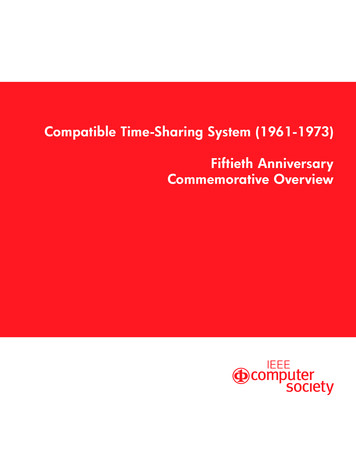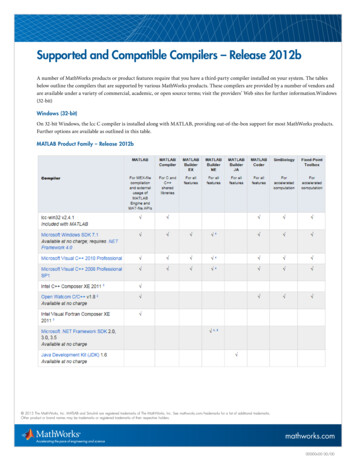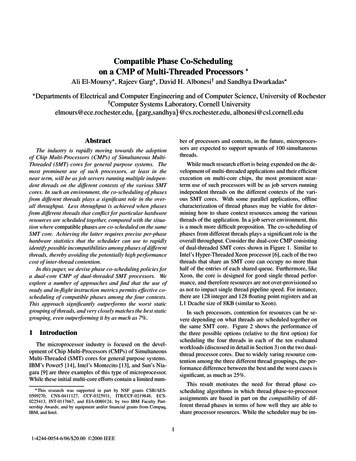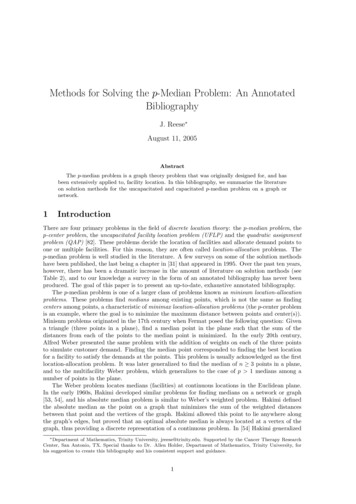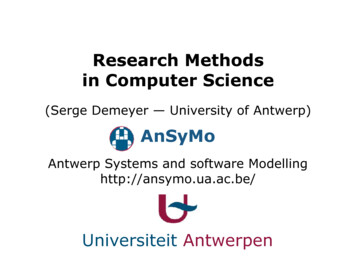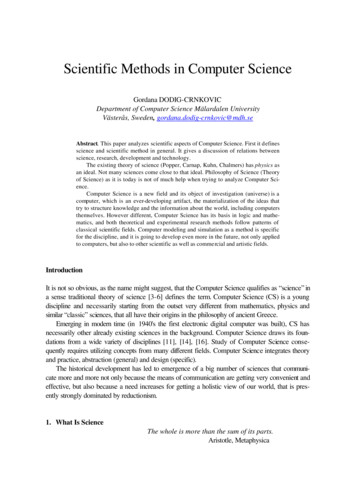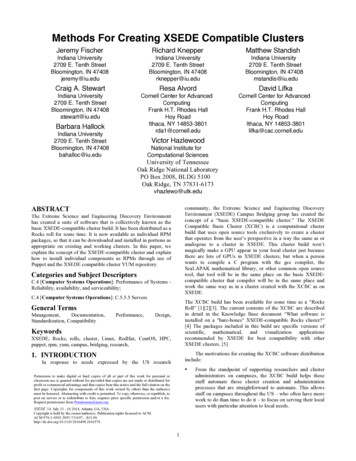
Transcription
Methods For Creating XSEDE Compatible ClustersJeremy FischerRichard KnepperMatthew StandishIndiana University2709 E. Tenth StreetBloomington, IN 47408jeremy@iu.eduIndiana University2709 E. Tenth StreetBloomington, IN 47408rknepper@iu.eduIndiana University2709 E. Tenth StreetBloomington, IN 47408mstandis@iu.eduCraig A. StewartResa AlvordDavid LifkaIndiana University2709 E. Tenth StreetBloomington, IN 47408stewart@iu.eduCornell Center for AdvancedComputingFrank H.T. Rhodes HallHoy RoadIthaca, NY 14853-3801rda1@cornell.eduCornell Center for AdvancedComputingFrank H.T. Rhodes HallHoy RoadIthaca, NY 14853-3801lifka@cac.cornell.eduBarbara HallockIndiana University2709 E. Tenth StreetBloomington, IN 47408bahalloc@iu.eduVictor HazlewoodNational Institute forComputational SciencesUniversity of TennesseeOak Ridge National LaboratoryPO Box 2008, BLDG 5100Oak Ridge, TN 37831-6173vhazlewo@utk.eduABSTRACTcommunity, the Extreme Science and Engineering DiscoveryEnvironment (XSEDE) Campus Bridging group has created theconcept of a “basic XSEDE-compatible cluster.” The XSEDECompatible Basic Cluster (XCBC) is a computational clusterbuild that uses open source tools exclusively to create a clusterthat operates from the user’s perspective in a way the same as oranalogous to a cluster in XSEDE. This cluster build won’tmagically make a GPU appear in your local cluster just becausethere are lots of GPUs in XSEDE clusters, but when a personwants to compile a C program with the gcc compiler, theScaLAPAK mathematical library, or other common open sourcetool, that tool will be in the same place on the basic XSEDEcompatible cluster that compiler will be in the same place andwork the same way as in a cluster created with the XCBC as onXSEDE.The Extreme Science and Engineering Discovery Environmenthas created a suite of software that is collectively known as thebasic XSEDE-compatible cluster build. It has been distributed as aRocks roll for some time. It is now available as individual RPMpackages, so that it can be downloaded and installed in portions asappropriate on existing and working clusters. In this paper, weexplain the concept of the XSEDE-compatible cluster and explainhow to install individual components as RPMs through use ofPuppet and the XSEDE compatible cluster YUM repository.Categories and Subject DescriptorsC.4 [Computer Systems Operations]: Performance of Systems Reliability, availability, and serviceability;C.4 [Computer Systems Operations]: C.5.5.5 ServersThe XCBC build has been available for some time as a “RocksRoll” [1][2][3]. The current contents of the XCBC are describedin detail in the Knowledge Base document “What software isinstalled on a "bare-bones" XSEDE-compatible Rocks cluster?”[4] The packages included in this build are specific versions ofscientific, mathematical, and visualization applicationsrecommended by XSEDE for best compatibility with otherXSEDE clusters. [5]General TermsManagement,Documentation,Standardization, CompatibilityPerformance,Design,KeywordsXSEDE, Rocks, rolls, cluster, Linux, RedHat, CentOS, HPC,puppet, rpm, yum, campus, bridging, research,The motivations for creating the XCBC software distributioninclude:1. INTRODUCTIONIn response to needs expressed by the US research Permission to make digital or hard copies of all or part of this work for personal orclassroom use is granted without fee provided that copies are not made or distributed forprofit or commercial advantage and that copies bear this notice and the full citation on thefirst page. Copyrights for components of this work owned by others than the author(s)must be honored. Abstracting with credit is permitted. To copy otherwise, or republish, topost on servers or to redistribute to lists, requires prior specific permission and/or a fee.Request permissions from Permissions@acm.org.XSEDE '14, July 13 - 18 2014, Atlanta, GA, USACopyright is held by the owner/author(s). Publication rights licensed to ACM.ACM 978-1-4503-2893-7/14/07 om the standpoint of supporting researchers and clusteradministrators on campuses, the XCBC build helps thesestaff automate those cluster creation and administrationprocesses that are straightforward to automate. This allowsstaff on campuses throughout the US – who often have morework to do than time to do it – to focus on serving their localusers with particular attention to local needs.
modules as RPMs (RedHat Package Manager). a similar model ofpackaging and distributing software was created. In addition to acluster building mechanism, a means of creating an easilyadoptable methodology was to be created. These packages can bedownloaded and installed individually as needed to establish ormaintain an XSEDE-compatible cluster.From the standpoint of XSEDE in its goals to support thenational research community, the distribution of these toolswill lead over time to the creation of more clusters that areset up in a relatively consistent way – consistent with eachother and consistent with the open source software setup ofthe least esoteric of the XSEDE clusters. (The XCBC isbased heavily on the open source software installed on theTACC Ranger and Stampede systems). This consistency willmake it easier to re-use training materials created for and byXSEDE systems.Making RPMs easily usable can be done with a pair of toolscalled YUM and Puppet. YUM, an acronym for YellowdogUpdater Modified, is a set of tools for creating repositories ofRPMs, and perhaps the most widely used tool developed from theYellowdog Linux distribution. Puppet is an open-sourceconfiguration management tool that facilitates deployment,configuration, and management of servers.Over the long run, the inclusion of integration tools – such asGlobus Online, Execution Management Services (EMS),Global Federated File System (GFFS), etc. – will make iteasier to integrate clusters on campuses and XSEDE into awell-integrated national cyberinfrastructure. The option ofincluding tools on local clusters will make it easier for theUS open research community to align its cyberinfrastructurearound XSEDE.In the rest of this paper, we describe the existing Rocks-basedXCBC build, the XSEDE YUM repository with a collection ofRPMs that enable an administrator to add the XCBC tools to anexisting cluster, and the use of the Puppet configuration manager.Figure 1 is a flowchart that depicts which tool to use, and when,and then explain the use of these tools in the remainder of thispaper.We see this project as an Education, Outreach, and Training(EOT) effort because the goals – and much of the really hard work– are primarily in the EOT area. Our work with campuschampions and information technology professionals at smallcolleges and universities – and Historically Black Colleges andUniversities (HBCUS) in particular – has confirmed that it istypical that there are inadequate staff resources to administer andsupport local cyberinfrastructure resources. Our interactions withfaculty at such schools have confirmed consistently that one of themost difficult types of time to get – officially as an allocation of afaculty member’s effort – is time for curriculum development.The outcome of our work is that faculty at small colleges withlimited time for curriculum development can create a XCBC andmake use of curriculum tutorials made about XSEDE resources,thus saving themselves the trouble of re-creating new materialsspecialized for local resources. Also, if faculty members happenalso to be their own cluster administrators – as is often the case –the cluster administration becomes easier and less timeconsuming. There is relatively little that is being done in theXCBC project that is development of new technology. Thisproject is primarily involved in packaging and distributingexisting technology developed by XSEDE or others. The work ispackaging the software in a way that is usable and easily used bythe national open research community generally. (Moreinformation on the user needs that drove the creation of the XCBCis available in the XSEDE Campus Bridging Use Cases document.[6].Figure 1. Campus Bridging Service Selection Flowchart [1]2. ROCKS ROLLSThe Rocks-based XCBC distribution is wonderful for peoplebuilding a cluster for the first time, or for people so unhappy withtheir current cluster configuration that they want to start over fromscratch. In addition, the Rocks distribution of the XCBC build hashad some important successes already. However, this approachmay not be the best one in the case of a cluster that is already wellset up and administered. Nationwide, there are more universities,colleges, departments, labs, and individuals with adequatelymanaged clusters who want to add this functionality than there aresuch entities that want to build a cluster from scratch. XSEDE isthus following the lead of the Open Science Grid (OSG) increating a mechanism for downloading and adding specificpackages and functionality to an already working cluster to makeit function in a way compatible with XSEDE clusters (in additionto, rather than instead of, the cluster’s current capabilities) [7].OSG pioneered the approach of distributing such softwareRocks is an open source cluster distribution solution thatsimplifies the processes of deploying, managing, upgrading, andscaling high-performance parallel computing clusters. Rocks isdesigned to help scientists with little or no cluster experiencebuild supercomputers that are compatible with systems used bynational computing centers and international grids. [8]The Rocks group has been addressing the problem of creatingeasily deployed and managed clusters since the turn of thiscentury. [9] They have created a system to install a commonLinux operating system (CentOS) and a means to managecomputational nodes from a central (frontend) node. [3] Thismethod creates a fairly simple to deploy basic cluster. Using aninternal database, Rocks can manage many compute nodes. Thismanagement allows an administrator to easily add, remove, andupgrade software across nodes and to maintain a uniform2
environment. This allows an institution with limited resources toeasily create and maintain a cluster.Creating a notification script so that packages may be reviewedand tested on non-production nodes or systems might be the moreprudent action. There are several tools available that do this suchas yum-updatesd developed by Duke and available from CentOSand other distribution packagers.While Rocks uses a common Linux variant and packages, theRocks method is a bit more rigid in design. This allows for apredictable, repeatable result in creating clusters. Thedevelopment of Rocks is active but may often be slow to react tonewer versions of software and operating systems. For instance, atthe time of writing this paper, the current OS in Rocks 6.1 isCentOS 6.3. The version of CentOS in Rocks 6.1 is two revisionsback from the current CentOS release of 6.5. Rocks expects tocreate a new version based on 6.5 during 2014, but this is anexample of how Rocks may not be the best choice for institutionswith higher IT staffing levels and cluster experience. Since theinitial revision and acceptance of this paper, Rocks has released anew version of the OS, version 6.3, utilizing CentOS 6.5.4. USING PUPPETPuppet is an open-source configuration management tool createdby Puppet Labs. Puppet provides methods to deploy, configure,manage and maintain servers and can be deployed on a variety ofLinux based operating systems including RedHat/CentOSvariants, Debian and Ubuntu, as well as Mac OS X and Windows.Once you install puppet on all nodes and the puppet-masterpackage on the frontend node and do the necessary configuration,you can use Apache and Puppet to maintain packages andconfigurations from the frontend node.That aside, using the XSEDE roll during the Rocks cluster installwill give a cluster the packages necessary to have an XSEDEcompatible cluster. Once you are up and running, to maintain thepackage levels, you can enable the XSEDE Yum repository andthen follow the Rocks instructions or use the preferred methodand create an update roll to add to your distribution. [10] Thedown side to Rocks upgrades is that neither method will mostlikely seem easy to the novice administrator. The long term resultis that while clusters are relatively easy to bring online andexpand, upgrading and other more in-depth maintenance may bedaunting to less experienced users. This may lead to clusters notbeing maintained, not kept secure, and not kept upgraded with thelatest XSEDE-compatible cluster software. These problems aside,Rocks may be the best solution for getting an XSEDE compatiblecluster up for institutions that may have to depend on graduatestudents, faculty, or shared IT staff for installing and maintainingan XSEDE-compatible cluster.Using Puppet alone doesn’t give any direct high performancecomputing capabilities. An administrator can use Puppet to installXSEDE-compatible software and bring an XSEDE-compatiblecluster online fairly easily. Utilizing Puppet and specificrecipes/patterns in conjunction with the XSEDE Yum repositorycan ensure that you have an up to date XSEDE-compatible clusterat all times.Puppet is extremely flexible and allows an almost endless array ofmanagement tasks to be performed. You can find Puppet recipesfor building/installing new servers, managing servers/users,maintaining content management systems such as Drupal, and thelist goes on and on. To that effort, creating downloadable recipesfor those already using Puppet to easily deploy an XSEDEcompatible cluster would be yet another way of ensuring acompatible research infrastructure. Beyond that, developing abase set of recipes and documentation for deploying an XSEDEcompatible cluster using Puppet to add XSEDE software to anexisting cluster would be a logical next step for Campus Bridgingefforts within XSEDE. Taking that idea further might be to createa Kickstart image and basic Puppet recipes to allow people tocreate an XSEDE compatible cluster from scratch outside ofRocks.3. USING YUMYellowdog updater modified (Yum) is a package manager thatwas developed by Duke University to improve the installation ofRPMs. [11] Yum helped solved the problem of dependency issuesfor RedHat based installations by checking not only for updatesbut also for any updates that are a dependency for the initialpackage being updated. Using a series of repository configurationfiles, it can check as many or as few repositories as theadministrator would prefer.5. CASE STUDIES5.1 Marcus Alfred, Howard UniversityHoward University “is one of only 48 U.S. private,Doctoral/Research-Extensive universities, comprising 12 schoolsand colleges with 10,500 students enjoying academic pursuits inmore than 120 areas of study leading to undergraduate, graduate,and professional degrees. The University continues to attract thenation’s top students and produces more on-campus AfricanAmerican Ph.Ds. than any other university in the world” [12]Yum itself does not provide any cluster capabilities. It merelyprovides a mechanism for easily maintaining packages. To utilizeYum in creating an XSEDE-compatible cluster, an administratorwould need to initially set up the repository configuration. Thereare two ways to do this: (1) install the XSEDE repo RPM fromhttp://cb-repo.iu.xsede.org/xsederepo or (2) install the yumplugin-priorities package and then create the file/etc/yum.repos.d/xsede.repo with the lines specified in epo.Dr. Marcus Alfred is an Associate Professor of Physics at HowardUniversity. “Howard University is an active research university,but without a centralized HPC (high-performance computing)Center," says Marcus Alfred, professor of physics, HowardUniversity. As a researcher working in computational nuclearphysics, Dr. Alfred manages his own computing cluster out ofnecessity. He was so enthused about the capabilities of the basicXSEDE-compatible compute cluster that he restarted his clustersetup from scratch using the XCBC build from the Rocks Roll. Ashe put it, "the time of faculty members is precious, and the ease ofan XSEDE Rocks Roll makes this unbeatable as a help for us tomanage our clusters."As new packages are created, when “yum update” is called, it willfind any new packages in the repositories your server is using andwill try to resolve any dependencies for those packages and thenprovide the administrator with a full list of packages to beupdated. Yum still requires an administrator to run update checksperiodically. There are tools available (or admins can write theirown scripts and cron jobs) to either automate Yum updates or tonotify administrators of the availability of package updates.Updating packages automatically may be a dangerous propositionin a production environment, causing unexpected issues to arise.3
5.2 DAUIN HPC InitiativeMarcus Alfred of Howard University – that the second caseactually exists. But these cases are also not usual. Much moreoften, a lab, group, or campus will have a cluster that is alreadywell to very well set up, but the administrators and users will seevalue in adding software to create compatibility and/orinteroperability with XSEDE clusters. For this purpose, thecombination of Puppet and a YUM repository of RPMs is a verypractical choice – much better than starting over from scratch. Wehave demonstrated the value of this approach as well.The Department of Control and Computer Engineering (DAUIN)is an organization that “conducts research and teaching” and“consists of over 60 teachers and researchers, nearly 100 graduatestudents and about 20 technicians and administrative staff.” [13]Beginning in 2008, the DAUIN HPC initiative sought to createusable HPC resource in a time of economic stagnation. Theirgoals were terascale processing power, multipurpose computingusing open source software, making it a shared resource, all whileworking in a modest budget of 13,500 Euros. [14]The NSF budget cannot meet the collective cyberinfrastructureneeds of all open research activities in the US, any more than theNSF budget could have funded all of the networking needs ofopen US researchers in the 1990s. Leadership and funding ofNSFNET aligned networking technology throughout the US tocreate the current modern Internet. In a way that is analogous(although technically different), we believe that XSEDE and rastructure. There is a technical difference: networkstandards create a stronger need for standards compliance in orderto achieve interoperability than is needed for interoperability ofcomputational clusters. But the concept of aligning effort andachieving economies of scale applies to the case of XSEDE andclusters throughout the US generally. While no sensible personwould diminish the importance of cloud computing, there aremany benefits to the possession and management of local andlocally owned compute clusters as well.The OS choice for the Casper 3 project was Rocks. This choicewas made because it was based on CentOS, integrates OS andmanagement layers, easy to install, manage, and add nodes, andhelped maximize the benefits of HPC on a small resource. Rocksalso gave them pre-configured software for an HPC environment.[14] All of these add up to create a cluster environment that wouldbe easier to support than some alternative means.This sort of small cluster capability is exactly what the XSEDEcompatible cluster project strives for. While DAUIN is part of thedomain of the Partnership for Advanced Computing in Europe(PRACE), a sister organization to XSEDE, the problems are thesame whether in the United States or abroad. There is limitedfunding for hardware, especially for smaller organizations, and thehuman resources for supporting HPC projects continues to belimited, as well. Organizations such as DAUIN might also benefitfrom the software provided in an XSEDE compatible cluster.The
existing cluster, and the use of the Puppet configuration manager. Figure 1 is a flowchart that depicts which tool to use, and when, and then explain the use of these tools in the remainder of this paper. Figure 1. Campus Bridging Service Selection Flowchart [1] 2. ROCKS ROLLS Rocks is an open s
